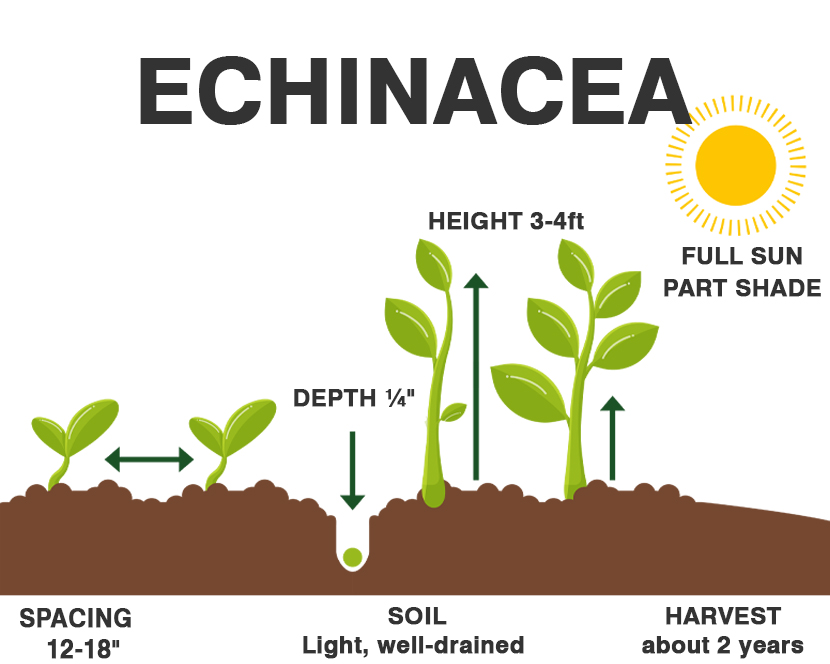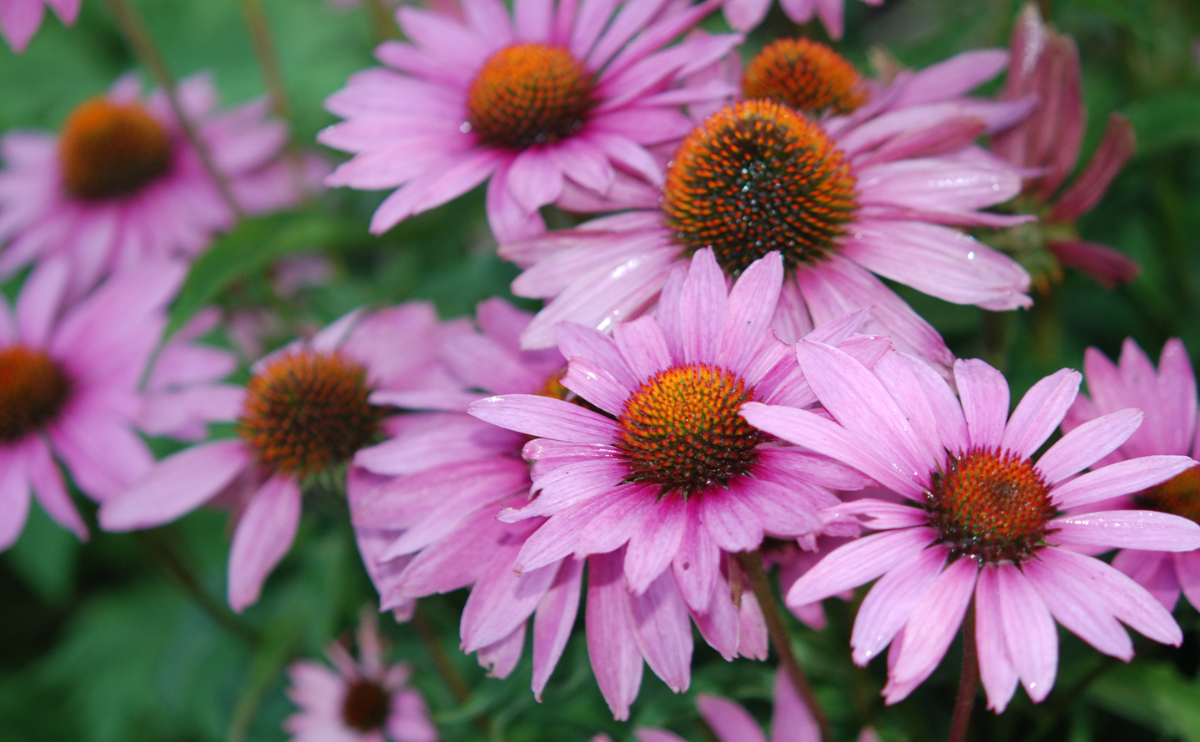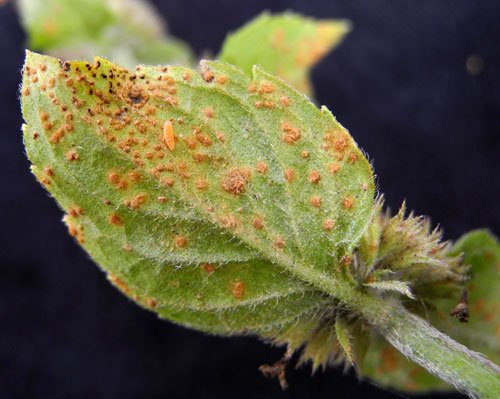Coneflowers are quintessential prairie plants. Native to eastern North America, they are hardy, drought-tolerant, long-blooming, and cultivated in an ever-widening range of colors. It’s hard to find a garden without at least one variety of the bloom. Best planted in early spring (after the final frost), coneflowers will germinate in about three to four weeks and produce leaves in three months but can take up to two years to actually produce blooms.
Purple coneflower, or Echinacea purpurea, is by far the most popular variety of coneflower. It has a fibrous root system, rather than the long taproot and woody crown found in other native species, making it more adaptable to garden conditions, and more forgiving of dividing and transplanting.
Coneflower’s daisy-like booms are actually made up of several small flowers, with petals that are sterile to lure insects toward the many fertile flowers in the central disk or cone. These flowers are rich in nectar and very popular with both bees and butterflies. Hummingbirds also enjoy coneflowers, and birds like finches eat (and spread) the seeds.

| Botanical Name | Echinacea purpurea |
| Common Name | Purple coneflower |
| Plant Type | Herbaceous perennial |
| Mature Size | 2–5 ft. tall, 1–2 ft. wide |
| Sun Exposure | Full sun, partial shade |
| Soil Type | Well-drained |
| Soil pH | Neutral to acidic |
| Bloom Time | Summer |
| Flower Color | Purple, pink |
| Hardiness Zones | 3-8 (USDA) |
| Native Area | North America |

When to Plant?
This will be determined by your planting zone. There is a final frost date for each area. As a result, you can plan your gardening activities around this date. Check our Frost Dates Across North America: First & Last Frost Dates Chart. However, the date will not be the same for every plant.
How to Plant
Purple coneflowers grow well just about anywhere in USDA hardiness zones three through nine, but in colder climates, you may want to give them a little winter protection in their first year. However, once established, coneflowers are rugged and hardy.
Coneflowers grow well from seed and can be divided to make new plants. They can also be grown from stem cuttings, but often with less success. They’re easily found in garden centers and can also be purchased via mail order. Coneflowers start blooming in early summer and will repeat bloom throughout the first frost. They may take a break after their initial bloom period, but they will quickly set more flower buds.

How to Cultivate
Purple coneflowers are relatively easy to grow from seed. If you’d like to save the seed, wait until the cone has fully dried—it should be darker and stiff to the touch. The seeds are attached to the sharp spines, so you’ll want to wear gloves, and separate the seeds from the cone. Spread them on a paper plate or screen to dry thoroughly before storing.
The seeds germinate best with some cold stratification. The easiest method is to sow them outdoors in the fall, either in the ground or in winter sowing them in milk jugs. If you are going to start seed indoors, simulate the chilling period by planting seeds in a damp seed starting mixture and placing the sealed container in the refrigerator for eight to 10 weeks. Then, take them out and plant them as you normally would. The seeds need darkness to germinate, so plant them about half an inch deep and cover them with soil. They should germinate within 10 to 14 days. Place the seeds under grow lights that are about an inch or two above the plant once the seedlings emerge.
How to Harvest
Harvest coneflowers beginning in their second year. Pick leaves anytime during the flowering cycle, or harvest the flowers when the buds just begin to open.
Cut through the stem with a sharp pair of shears. Make the cut just above the lowest set of leaves for foliage harvesting, or cut above the topmost leaf set if you are only harvesting flower buds.
Strip the leaves from the stem after harvest. Cut off the flower buds just behind the flower head. Dispose of the remaining stem.
Spread the flower buds and leaves out on a drying screen. Place them in a warm, dry room with good circulation where they aren’t exposed to intense light or heat. Dry the coneflower parts for five to seven days, or until they feel brittle and papery.
Store the dried coneflower leaves and flowers in a sealed container in a cool, dark, and dry place until use.
Hydroponics
Germination: You can start by germinating Purple coneflower seeds in a paper towel or directly in the growing medium of your hydroponic system.
pH range: The ideal pH range for Purple coneflower hydroponic growth is between 6.0 and 7.0. Monitor the pH levels regularly and adjust them accordingly using pH up or down solutions.
EC: The ideal electrical conductivity (EC) range for Purple coneflower hydroponics is between 1.2 and 1.8 mS/cm. Keep in mind that EC measures the level of nutrients in the solution, so you may need to adjust nutrient levels to maintain the appropriate EC range.
PPM: The ideal PPM (parts per million) range for Purple coneflower hydroponics is between 500 and 1000 ppm. Again, this range will depend on the specific nutrients you use, so monitor the PPM levels regularly and adjust as needed.
Humidity: Purple coneflower prefers a relatively low humidity level, around 40-50%. Maintain proper humidity levels by using a dehumidifier or ensuring proper ventilation in your hydroponic system.
Light hours: Purple coneflower requires at least 12-16 hours of light per day for proper growth. Use LED grow lights or natural sunlight to provide your plants with enough light.
Temperature air: Purple coneflower plants grow best in temperatures between 65-75°F (18-24°C). Make sure to maintain a stable temperature range in your hydroponic system.
Temperature water: The ideal water temperature for Purple coneflower hydroponics is around 70°F (21°C). Too cold or too hot water can affect plant growth, so keep an eye on water temperature regularly.
That’s it! With the right conditions and attention, you should be able to successfully grow Purple coneflower (Echinacea) hydroponically.



